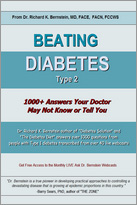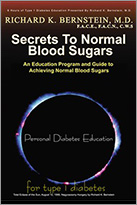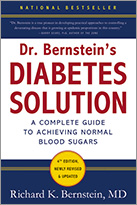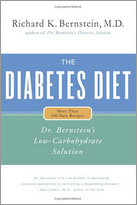Most of this book is instructional, of the how-to variety. The intent of this appendix is to provide you with a little of the science that surrounds the program described in the rest of the book. With respect to a number of the issues raised in this section, I would also refer you again to Gary Taubes’s award-winning Science article The Soft Science of Dietary Fat. Another masterpiece by Taubes, What If It’s All Been a Big Fat Lie? appeared as the cover article in the New York Times Magazine of July 2, 2002.
I hope that I can cut through some of the myths that cloud diet and the treatment of diabetic complications so that you will have the why that supports the how-to. We’ve already discussed some of the myths. We’ll look at the origins of those myths to try to give you as many of the facts as are available at this writing. If your only interest is in the how-to, feel free to skip this appendix.
Once you’ve started to follow a restricted-carbohydrate diet, you may find yourself pressured by well-meaning but uninformed friends or family, or even newspaper articles, to cease penalizing yourself and eat more “fun” foods—sweets, bread, pasta, and fruits. This chapter will provide you with specific scientific information that underpins my approach and will perhaps give you some ammunition for responding to this pressure. Even if you skip it now, you may want to come back to it later, or show it to your loved ones to lay their concerns to rest. As I don’t expect most readers to be scientists, I’ve tried to keep all these explanations relatively simple. Some of the explana- tions may at this moment represent more theory than fact, but they’re based on the latest information available to us.
HOW DID THE COMMONLY PRESCRIBED HIGH-CARBOHYDRATE DIET COME ABOUT?
If, like me, you’ve had diabetes for a while, you’ve probably been told to cut way down on your dietary intake of fat, protein, and salt, and to eat lots of complex carbohydrate. You may even still read this advice in publications circulated to diabetic patients.
Why is such advice being promulgated, when the major cause of such diabetic complications as heart disease, kidney disease, high blood pressure, and blindness is high blood sugar?
When I first developed diabetes, in 1946, little was known about why this disease, even when treated, caused early death and such distressing complications. Prior to the availability of insulin, about twenty-five years earlier, people with type 1 diabetes usually died within a few months of diagnosis. Their lives could be prolonged somewhat with a diet that was very low in carbohydrate and usually high in fat. Most sufferers from the milder type 2 diabetes survived on this type of diet,without supplemental medication. When I became diabetic, oral hypoglycemic agents were not available, and many people were still following very low carbohydrate, high-fat diets. It was at about this time that diets very high in saturated fats, with resultant high serum cholesterol levels, were experimentally shown to correlate with blood vessel and heart disease in animals. It was promptly assumed by many physicians that the then-known complications of diabetes, most of which related to abnormalities of large or small blood vessels, were caused by the high-fat diets. I and many other diabetics were therefore treated with a high-carbohydrate, low-fat diet. This new diet was adopted in the mid-1940s by the American Diabetes Association (ADA), the New York Heart Association, and eventually by the American Heart Association (AHA) and other groups around the world. On the new diet, most of us had much higher serum cholesterol levels, and still developed the grave long-term complications of diabetes. Seemingly unaware of the importance of blood sugar control, the ADA raised the recommended carbohydrate content from 40 to 50 percent of calories, and then more recently to 60 percent. The ADA’s most recent guidelines have backed off by vaguely stating that some diabetics may do better with less carbohydrate.
RECENT DEVELOPMENTS REGARDING RISK FACTORS FOR HEART DISEASE
In the past twenty years, research studies have generated considerable new information about heart disease and vascular (blood vessel) disease in general, and their relationship to diabetes in particular. Some of this more recent information is summarized here.
A number of substances have been found in the blood which relate to risk of heart attacks and vascular disease. These include HDL (highdensity lipoprotein), LDL (low-density lipoprotein), triglyceride, fibrinogen, homocysteine, C-reactive protein, and lipoprotein(a). High serum levels of LDL, triglyceride, fibrinogen, homocysteine, C-reactive protein, and lipoprotein(a) tend to be associated with increased cardiovascular risk, while high levels of HDL tend to protect from cardiovascular disease. Cholesterol is a component of both LDL and HDL particles. The fraction of total cholesterol found in LDL particles is an index of risk, while the fraction of cholesterol found in HDL particles is an index of protection. Nowadays, when we want to estimate the effects of lipids (fatty substances) upon the risk of coronary artery disease, we look at the ratio of total cholesterol to HDL and also at fasting triglyceride levels. Someone with high serum HDL can thus have a high total cholesterol and yet be at low statistical risk for a heart attack. Conversely, a person with low total cholesterol and very low HDL may be at high risk.
A large multicenter study (the Lipid Research Clinics Trial) investigated the effects of a low-fat, high-carbohydrate diet versus a high-fat, low-carbohydrate diet on nondiabetic middle-aged men with elevated cholesterol levels. The study followed 1,900 people for seven years. Throughout this period, total cholesterol had dropped only 5 percent from baseline in the low-fat group, but serum triglyceride went up about 10 percent! (Serum triglyceride rises very rapidly after a highcarbohydrate meal in nondiabetics, and moves up and down with blood sugar levels in most diabetics.) As with prior studies, no significant correlation was found between serum cholesterol levels and mortality rates. Furthermore, a study reported in the Journal of the American Medical Association in 1997 showed that a 20 percent increase in either saturated or monounsaturated dietary fat lowered the risk of stroke to one-eighth of what it was in individuals on lower-fat diets. Unsaturated fats showed no such benefit.
On average, diabetics with chronically high blood sugars have elevated levels of LDL (the “bad” cholesterol) and depressed levels of HDL (the “good” cholesterol), even though the ADA low-fat diet has now been in use for many years. Of great importance is the recent discovery that the forms of LDL that harm arteries are small, dense LDL, oxidized LDL, and glycated LDL. All of these increase as blood sugar increases. In addition, independently of blood sugars, high serum insulin levels dictated by high-carbohydrate diets bring about increased production of small, dense LDL particles and enlargement of the cells lining the arteries.
Under normal conditions, receptors in the liver remove LDL from the bloodstream and signal the liver to reduce its manufacture of LDL when serum levels rise even slightly. Glucose may bind to the surface of the LDL particle and also to liver LDL receptors, so that LDL cannot be recognized by its receptors. In people with high blood sugars, many LDL particles become glycosylated, and are therefore not cleared by the liver. This glycosylation is reversible if blood sugar drops. After about 24 hours, however, a rearrangement of electron bonds occurs in glycosylated proteins, so that the glucose can’t release even if blood sugar drops. This irreversible glycosylation is called glycation, and the affected protein molecules are said to be “glycated.” They are also referred to as AGEs, or advanced glycosylation end products. These AGEs accumulate in the blood, where they can become incorporated into the walls of arteries, forming fatty deposits called atherotic plaques. Since liver LDL production cannot be turned off by the glycosylated/ glycated LDL (and also the presence of glycosylated/glycated LDL receptors), the liver continues to manufacture more LDL, even though serum levels may be elevated.
The proteins in the walls of arteries can also become glycosylated/ glycated, rendering them sticky.Other proteins in the blood then stick to the arterial walls, causing further buildup of plaque. Serum proteins glycosylate in the presence of glucose.White blood cells called macrophages ingest glycosylated/glycated proteins and glycosylated/ glycated LDL. The loaded macrophages swell up, becoming very large. These transformed macrophages, loaded with fatty material,
are called foam cells. The foam cells penetrate the now sticky arterial walls, causing disruption of the orderly architecture of the artery, and narrow the channel through which blood can flow.
The middle layer of the walls of large arteries contains smooth muscle cells that can invade the fatty coating (plaque) that these cells create. They then prevent the plaque from breaking loose. When the nerves that control this smooth muscle die, as in diabetic autonomic neuropathy (caused by high blood sugars), the muscle layer dies and calcifies. It then cannot prevent plaque rupture. When a piece of ruptured plaque enters the blood it can block narrow vessels upstream
and cause a heart attack.
In recent years, the tendency of blood to clot has come into focus as a major cause of heart attacks. People whose blood clots too readily are at very high risk. You may recall that one of the medical names for a heart attack is coronary thrombosis. A thrombus is a clot, and coronary thrombosis refers to the formation of a large clot in one of the arteries that feed the heart. People who have elevated levels of certain clotting precursors or depressed levels of clotting inhibitors in their blood are at high risk of dying from heart attacks. This risk probably far exceeds that caused by high LDL or low HDL. Some of the blood factors that enhance clotting include fibrinogen and factor VII. Another factor, lipoprotein(a), inhibits the destruction of small thrombi before they become large enough to cause a heart attack. All of these factors have been found to increase in people with chronically high blood sugars. Platelets, or thrombocytes, are particles in the blood that play major roles in the blocking of arteries and the formation of clots. These have been shown to clump together and stick to arterial walls much more aggressively in people with high blood sugars. What is exciting is that all of these factors, including sticky platelets, tend to normalize as long-term blood sugars improve. Diabetics die from heart failure at a rate far exceeding that of people with normal glucose tolerance. Heart failure involves a weakening of the cardiac muscle so that it cannot pump enough blood.Most longterm, poorly controlled diabetics have a condition called cardiomyopathy. In diabetic cardiomyopathy, the muscle tissue of the heart is slowly replaced by scar tissue over a period of years. This weakens the muscle so that it eventually “fails.” There is no evidence linking cardiomyopathy with dietary fat intake or serum lipids.
A fifteen-year study of 7,038 French policemen in Paris reported that “the earliest marker of a higher risk of coronary heart disease mortality is an elevation of serum insulin level.” A study of middleaged nondiabetic women at the University of Pittsburgh showed an increasing risk of heart disease as serum insulin levels increased. Other studies in nondiabetics have shown strong correlations between elevated serum insulin levels and other predictors of cardiac risk such as hypertension, elevated triglyceride, and low HDL. The importance of elevated serum insulin levels (hyperinsulinemia) as a cause of heart disease and hypertension has taken on such importance that a special symposium on this subject was held at the end of the 1990 annual meeting of the ADA. A report in a subsequent issue of the journal Diabetes Care quite appropriately points out that “there are few available methods of treating diabetes that do not result in systemic hyperinsulinemia [unless the patient is following a low-carbohydrate diet].”
Furthermore, research published in the journal Diabetes in 1990 demonstrated that elevated serum insulin levels cause excessive leakage of protein from small blood vessels. This is a common factor in the etiology of blindness (via macular edema) and kidney disease in diabetics.
Although the AHA and the ADA have been recommending lowfat, high-carbohydrate diets for diabetics for many decades, no one had compared the effects on the same patients of low- versus high-carbohydrate diets until the late 1980s. Independent studies performed in Texas and California demonstrated lower levels of blood sugar and improved blood lipids when patients were put on lower-carbohydrate, high-fat diets. It was also shown that, on average, for every 1 percent increase in HgbA1C (the test for average blood sugar over the prior four months), total serum cholesterol rose 2.2 percent and triglycerides increased 8 percent.
The National Health Examination Follow-Up Survey, which followed 4,710 people, reported in 1990 that “in the instance of total blood cholesterol, we found no evidence in any age-sex group of a risk associated with elevated values.” That’s right: they found no risk associated directly with elevated total cholesterol. On the same page, this study lists diabetes as by far the single most important risk factor affecting mortality. In males aged 55–64, for example, diabetes was associated with 60 percent greater mortality than smoking and double the mortality associated with high blood pressure.
The evidence is now simply overwhelming that elevated blood sugar is the major cause of the high serum lipid levels among diabetics and, more significantly, the major factor in the high rates of various heart and vascular diseases associated with diabetes. Many diabetics were put on low-fat diets for so many years, and yet these problems didn’t stop. It is only logical to look elsewhere, to elevated blood sugar and hyperinsulinemia, for the causes of what kills and disables so many of us.
My personal experience with diabetic patients is very simple. When we reduce dietary carbohydrate, blood sugars improve dramatically. After about two months of improved blood sugars, we repeat our studies of lipid profiles and thrombotic risk factors. In the great majority of cases, I see normalization or improvement of abnormalities.
* This parallels what happened to me more than thirty years ago, when I abandoned the high-carbohydrate, low-fat diet that I had been following since 1946.
Sometimes, months to years after a patient has experienced normal or near-normal blood sugars and improvements in the cardiac risk profile, we will see deterioration in the results of such tests as those for LDL, HDL, homocysteine, and lipoprotein(a). All too often, the patient or his physician will blame our diet. Inevitably, however, we find upon further testing that his thyroid activity has declined. Hypothyroidism is an autoimmune disorder, like type 1 diabetes, and is frequently inherited by diabetics and their close relatives. It can appear years before or after the development of diabetes and is not caused by high blood sugars. In fact, hypothyroidism can cause a greater likelihood of abnormalities of the cardiac risk profile than can blood sugar elevation. The treatment of a low thyroid condition is oral replacement of the deficient hormone(s)—usually one pill daily. The best screening test is free T3. If this is low, then a full thyroid risk profile should be performed. Correction of the thyroid deficiency inevitably corrects the abnormalities of cardiac risk factors that it caused.




